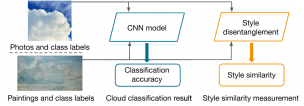Image Processing and the Analysis of Paintings—The Case of Serbian Baroque Icons

Technical studies of paintings are based on many analytical techniques that complement art historical studies. Understanding the processes that happen with the aging of the paint is very important for conservators. The paint layer cracks and lifts, the materials discolor and new layers are added over time, slowly changing the appearance of the artwork. Crack patterns in the paint layer can be used in the study of the composition of the paint layer as well as its conservation history, even for more in-depth studies of the artwork creation. Particularly interesting examples are coming from the transition periods in art history, in which the changes in the painting style and painting technique were happening. Image analysis powered by machine learning was applied in the study of the two Serbian Baroque icons. The resulting crack pattern, besides being valuable conservation documentation, opened new research questions regarding the origin of the degradation processes in the paint layer.




